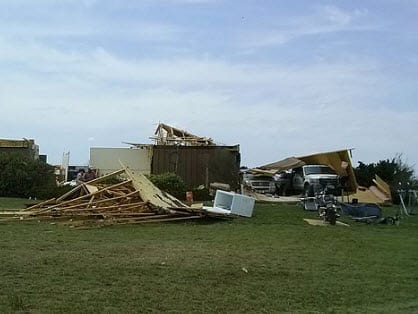BOSTON, May 21, 2013 – According to catastrophe modeling firm AIR Worldwide, at 3:01 p.m. on Monday, May 20, 2013, a massive tornado struck Moore, Oklahoma, a suburb of Oklahoma City, destroying many homes, businesses, and public buildings, including two elementary schools and a hospital. According to reports and aerial images, property damage in the affected region is extensive, with whole neighborhoods heavily damaged or destroyed.
“A slow-moving upper level low pressure system triggered a series of severe thunderstorm outbreaks across the Central Plains starting on May 19,” said Dr. Tim Doggett, senior principal scientist, AIR Worldwide. “The system coupled with very warm, humid air moving northward out of the Gulf of Mexico ahead of a surface cold front and wind shear associated with an approaching increase in jet stream energy. Together, these factors produced the highly unstable atmospheric conditions that caused the Monday afternoon storms to rapidly evolve into tornadic supercell thunderstorms. The tornadoes spawned by these supercell events were long-lived due to the orientation of the track and the severity of the conditions, leaving behind long and wide swaths of damage.”
Touching down about 5 miles south of Newcastle, Oklahoma, at 2:56 p.m., the powerful tornado tracked northeast for 40 minutes, traveling approximately 20 miles. The Moore tornado has been upgraded to an EF-5 rating by the National Weather Service, based on damage reports that are consistent with wind speeds of over 200 miles per hour. Based on reports and the size of the storm’s swath of destruction, the tornado was approximately a mile wide.
At 2:40 p.m., the National Weather Service Storm Prediction Center (SPC) alerted the town of Moore that a tornado was imminent. At 2:56 p.m., five minutes before the tornado struck, the SPC upgraded its emergency tornado war ning to include “heightened language,” stating that those in the path of the storm would be facing a life threatening situation and must take cover in a basement, storm shelter, or interior room. At 3:01 p.m., the tornado struck Moore and continued northeast, nearly paralleling Highway 37, eventually dissipating about 5 miles east of Moore.
ning to include “heightened language,” stating that those in the path of the storm would be facing a life threatening situation and must take cover in a basement, storm shelter, or interior room. At 3:01 p.m., the tornado struck Moore and continued northeast, nearly paralleling Highway 37, eventually dissipating about 5 miles east of Moore.
Dr. Doggett continued, “In all, this system produced 22 tornadoes on May 20, largely in Oklahoma, although tornadoes were also reported in Missouri, Texas, Kansas, Arkansas, and Colorado. (However, of these 22 tornadoes, the Moore event was by far the most damaging.) Many localized hailstorms occurred in the region as well, with quarter-size hail noted in Missouri and baseball-size hail reported in Osage County, about 100 miles northeast of Oklahoma City.”
Although basements and underground shelters are the safest refuge from a tornado, many homes in Oklahoma are built on concrete slabs-and thus lack basements-because the soil in the region renders basement construction too costly.
Dr. Doggett noted, “An official estimate of the number of destroyed homes has not yet been released; however, the 1999 EF-5 tornado that followed a similar path to Monday’s EF-5 Moore tornado destroyed more than 8,000 homes.”
AIR estimates that the replacement value of properties within a 0.4-mile buffer zone around the track of yesterday’s tornado (for a total width of 0.8 miles) is about USD 2 billion. Within a 1-mile buffer zone of the storm track (for a total width of 2 miles), AIR estimates a total replacement value of about USD 6 billion. These two buffer zones, and the differing estimated replacement value associated with them, reflect the uncertainty in the exact size of the tornado. However, it is important to note that the exposure within each buffer zone is not equally at risk from damaging winds. In fact, exposures on the periphery of the 1-mile buffer zone would experience wind speeds of F-0 force, and hence much lighter damage, than exposures
within the 0.4-mile buffer zone.
According to AIR, residential structures in the affected area are typically of wood-frame construction, which are more vulnerable to high winds and windborne debris than masonry structures. Commercial buildings are, on average, less vulnerable than residential structures or automobiles, but exhibit a broader damage distribution due to wide variations in construction practices and design. Light metal structures are the most vulnerable to high winds and can suffer severe to complete damage from tornadoes categorized as EF-2 or higher.
According to AIR, for all types of structures, roofs are often the first element to be damaged by tornado winds, as once a single shingle is removed, neighboring shingles can easily be penetrated and lifted. Tornado winds can peel off unsecured slates, roll metal roofs, and damage windward overhangs and eaves. In the direct path of the tornado, failure of the roof system weakens lateral support of walls, contributing to their collapse. On the periphery of the track, lower damage ratios are expected.
Damage assessments from the National Weather Service are ongoing, and it will take weeks to develop a more complete picture of the destruction.
Dr. Doggett concluded, “The associated upper level system and the surface cold front will be slowly moving east and northeast over the next couple of days. Therefore, a wide area of the central United States – including parts of Texas (including the Dallas region), Missouri, Illinois, Indiana, and Pennsylvania-may be at risk for strong winds, hail, and tornadoes as the week progresses.”
AIR will continue to monitor the situation, will provide updates as warranted by events and plans to dispatch a disaster survey team to the affected areas once search and rescue efforts have ended.
